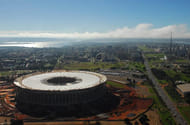When the country of Brazil spent an approximate sum of $3 billion for either newly building or upgrading the 12 stadiums that had hosted the 2014 World Cup fixtures, the officials had promised that these taxpayer-funded venues would serve as stadiums after the World Cup, continuing to raise revenue by hosting concerts, parties and other events.
However, as a report by the NPR suggests, most of the World Cup venues are struggling to generate funds, and have been turned into parking lots and other inglorious sites. Estádio Nacional de Brasília Mané Garrincha (Brasilia), the most expensive stadium, is now a municipal bus parking lot.
One of the major problems that these stadiums (including the $900 million stadium in Brasilia and the $600 million stadium in the rainforest city of Manaus,) have been facing is the failure to attract a large amount of crowd. Built in cities that normally host low-tier teams playing in the league, this was mainly done with the aim to spread the fixtures all over the country instead of just concentrating it to the south-east portion of Brazil, where the top teams generally come from.
According to a report by the NPR, a company that had bought the Arena da Dunas in Natal managed to earn just a little while renting it out for weddings and parties. Unsurprisingly, the stadium is up for sale again.
Besides this, what infuriates more is the displacing the hundreds of the thousands of people from their habitat for the construction of these new stadiums, thus rendering countless Brazilians homeless.
Although the 2014 FIFA World Cup was considered a base to upgrade the infrastructural development of Brazil, several big projects including the light-rail system in Sao Paulo, Cuiaba and Fortaleza are far from being finished and with just a year left for Rio de Janerio to host the 2016 Summer Olympics, the country is expected to spend a projected amount of $13.2 billion on the various infrastructural facilities, an amount expected to rise with each passing day.

